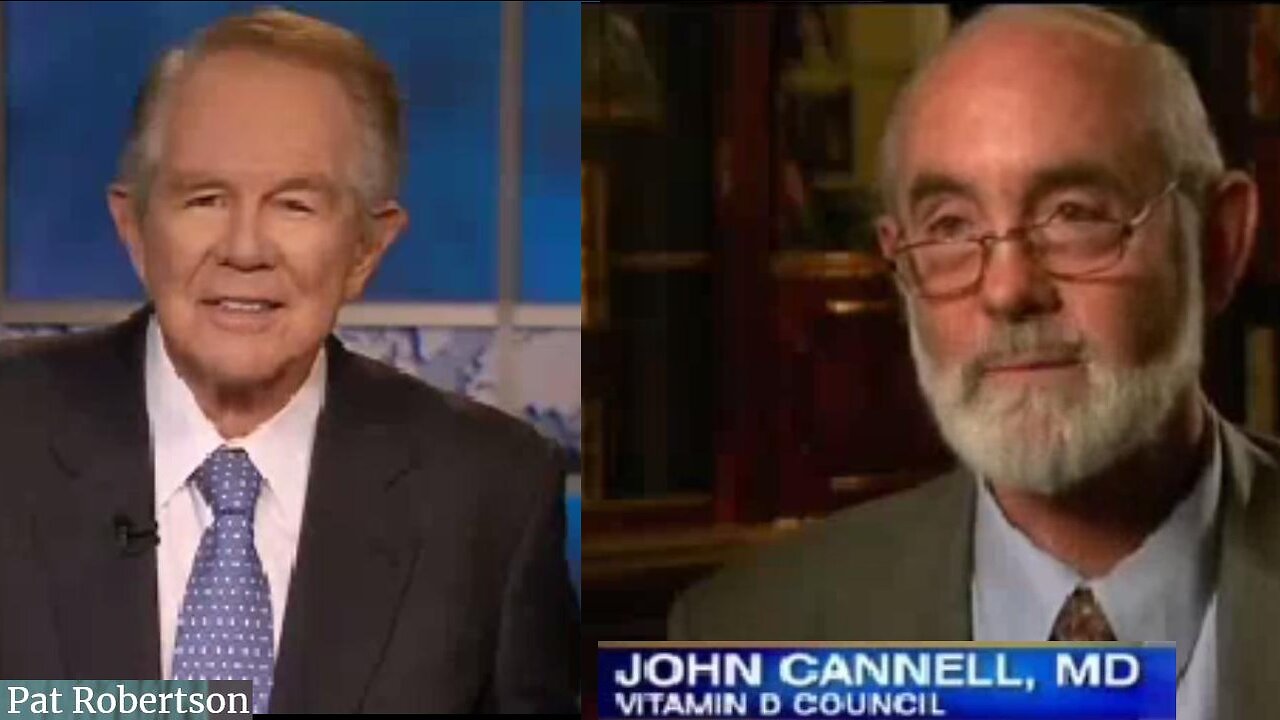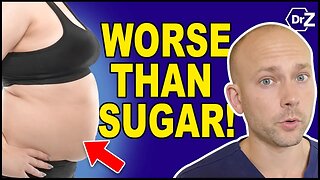Premium Only Content

Vitamin D3- Prevent Many Health Problems: CBN News - Pat Robertson - Dr Cannell 2009
(NaturalNews) Mike Adams recently interviewed the Executive Director of the Vitamin D Council, Dr. John Cannell, MD, in order to obtain more information about the nutrient which has been gaining ground as a proven necessity for cancer protection, good overall health, and a strong immune system. Vitamin D has been proven to reduce the risk of many types of cancer.
Listen to the full interview here:
http://soundcloud.com/healthranger/interview...
The Vitamin D Council -- a group of approximately 15 scientists, doctors, and PhDs, all respected in their fields -- provides research that proves the effectiveness of Vitamin D in severely lessening cancer risks. The Council recently reviewed the most relevant literature on Vitamin D and subsequently tripled the daily Vitamin D dose recommendations for healthy adults. Vitamin D is a powerful activator and supporter of immune response; Dr. Cannell discusses with Adams the specific role it plays in this response, in and why this is so crucial to preventative health and healing.
In the informative audio interview now available on NaturalNews, Dr. Cannell also speaks candidly with Mike Adams about various little-known facts and myths about Vitamin D and discusses the many reasons it plays a vastly important part in shaping the health of humans. This special interview is brimming with over an hour's worth of insight about significant Vitamin D-related facts.
Some examples of what else you will learn from Dr. Cannell in the interview:
• What the Vitamin D Council upped the daily Vitamin D dose recommendations to for adults, teens, children, and infants
• The links between Vitamin D deficiency and mental disorders such as schizophrenia and autism, as well as Vitamin D deficiencies and other disease like: diabetes, bone disorders, kidney health, cancer, mood, heart disease
• Why Vitamin D level affects so many different aspects of health and areas of the body through its numerous mechanisms of action
• How Vitamin D affects your genetic code and works in a very primitive way to treat and heal a variety of diseases
• Why Cannell recommends at least 5000 units of Vitamin D a day
• What percentage of breast milk in the US has no Vitamin D in it... it's a startling statistic!
• What percentage of human genomes are directly regulated by Vitamin D
• How Vitamin D affects the effectiveness (or lack thereof) of seasonal vaccines
• Why weaning toddlers from formula to juice is dangerous for their health and Vitamin D levels
• How you can calculate how much Vitamin D you are making outdoors just by viewing your shadow
• The best place to buy an affordable in-home blood test that properly measures your Vitamin D levels
• The effect our country's obsession with soap and cleanliness could be having on our Vitamin D levels
• How the cosmetology industry has played a huge part in the generation of the myth that sunlight is a carcinogen
• How Vitamin D acts as a chelating agent to rid your body of heavy metals and toxins
And much more!
This information about Vitamin D and its powerful ability to fight cancer risks and fortify your health is not something to miss out on.
To access the interview and soak up some beneficial Vitamin D wisdom, visit this link:
http://soundcloud.com/healthranger/interview...
https://www.naturalnews.com/033029_John_Cannell_vitamin_D.html
===========
Pat Robertson - He Obeyed God
“And we know that in all things God works for the good of those who love Him, who have been called according to His purpose.” — Romans 8:28
Pat Robertson dedicated his life to preaching the Gospel, helping those in need, and educating the next generation. He founded the Christian Broadcasting Network and numerous organizations, including Operation Blessing, Regent University, the American Center for Law and Justice, and International Family Entertainment Inc. He was also a New York Times best-selling author and host of The 700 Club.
Pat was married to the love of his life and partner in ministry for 67 years, Dede Robertson, until she died in 2022. Together, they had four children, 14 grandchildren, and 24 great-grandchildren.
Pat had a hunger for knowledge of the Lord, and he wanted to share the love and faithfulness of Jesus with the world. His heart's desire was that all people come to know Jesus. If you would like to know more about the God Pat loved, please click here. Learn more about his life and accomplishments at PatRobertson.com.
Biblical Teachings from Pat Robertson:
Watch some of Pat’s most popular and impactful biblical teachings:
https://www2.cbn.com/pat-robertson
https://dcenquirer.com/evangelist-pat-robertson-passes-away-aged-93
===========
Athlete's Edge: Faster, Quicker, Stronger With Vitamin D by John Cannell
How vitamin D improves athletic performance... and more
About the Book:
This book covers new ground. After extensive investigation and translation of numerous scientific reports into the English language, author Dr. John Cannell reveals a long-held secret once known only to Eastern European athletic trainers. In the 1960s and 70s, it was called Sunlamp Therapy, and it gives athletes a definitive edge over their competitors, particularly for athletes who train for indoor or winter sports. That vitamin D, the sunshine vitamin, improves muscle tone, muscle strength, balance, reaction time and physical endurance, as well as immunity and general health, is a recent discovery in western medicine. It has application ranging from improved performance of standing armies in the field, to Olympic and every-day athletes, and even seniors who need to avert falls and age-related loss of muscle mass and muscle tone. This ground-breaking book is a welcome addition to our current working knowledge of nutrition and health. Read it from beginning to end.
http://vitamindsportsbook.com/
===========
Update on Vitamin D role in Autism by Dr John Cannell March 2016
Posted on March 24, 2016
Courtesy of Dr John Cannell
Latest research on Vitamin D and Autism Spectrum Disorder (ASD)
I first wrote about vitamin D and the developing brain in 2005.
Vitamin D and the developing brain
I first published my hypothesis in a peer-reviewed journal in 2007, and my paper was met with deafening silence. However, in the last two months confirmatory research is pouring out. Within this paper, I will present data regarding the role of vitamin D in autism, including results from animal studies, three case series and a randomized controlled trial (RCT) completed around the time of a dramatic Pediatrics case report. I will also tell parents how to safely use the high dose vitamin D treatment for ASD.
Autism Spectrum Disorder [ASD], is a common neurodevelopmental disorder characterized by impaired communication, repetitive behaviours and social impairment. For the last 35 years, a dramatically increased incidence has occurred, possibly reflecting increased surveillance, over-diagnosis, a true increase in incidence or some combination of these explanations. As of 2010, ASD is diagnosed in 1 of every 64 American children by the age of eight (8) years. Vitamin D deficiency has been hypothesized to contribute to ASD as far back as 2007.1 High doses of vitamin D were first proposed to have a significant treatment effect on the core symptoms of autism in 2013 based on vitamin D’s mechanisms of action, in particular in anti-inflammatory properties.2
Possible mechanisms of action that explain vitamin D helping attenuating ASD are well known, are related to the fact vitamin D is not a vitamin (it is a pro-hormone) and has been recently reviewed.3, 4 Besides reducing risk or severity through it’s steroid hormone anti-inflammatory effects in the brain, vitamin D regulates DNA repair mechanism genes, has autoimmune effects, raises seizure threshold, increases T-regulatory cells, protects neural mitochondria, and up-regulates glutathione, the master antioxidant, which scavenges oxidative by-products.5 Vitamin D’s anti-inflammatory and anti- autoimmune properties in ASD were evident in Mostafa et al’s study of 50 children with ASD, aged 5-12, which found 25(OH)D levels were very highly correlated with the presence of an anti-neural antibody (r = – 0.86;P < 0.001)) and that serum 25(OH)D levels in children were highly correlated with the severity of ASD symptoms on the Childhood Autism Rating Scale (r = – 0.81;P <0.001).6
Another one of vitamin D’s steroid hormone mechanism is through vitamin D’s effect on serotonin via direct genetic regulation of serotonin’s rate limiting enzymes; both the gene for peripheral tryptophan hydroxylase (TPH)1 and the gene for central TPH2 require vitamin D for transcription. Activated vitamin D (the steroid hormone) genetically down-regulates TPH1 while it up-regulates TPH2, thus explaining the serotonin paradox in ASD in which peripheral serotonin is increased but central serotonin is decreased.7 It is not known if any or all of these are possible mechanisms of action; steroid hormones effect multiple genes in multiple ways; it is possible there are different mechanisms at work in different individuals.
A recent meta-analysis [11 cross-sectional studies] reported vitamin D deficiency was much more common in children with ASD than in controls (P=0.0002).8 A study in the Faroe islands, where – due to high latitude and cloud cover – most vitamin D is obtained from dietary fish, found that 40 young adults with ASD had much lower serum vitamin D levels (10 ng/ml) then did their 139 typically developing first degree relatives [17 ng/ml; P=0.003].9 Another family study found that 58 new-borns who later developed ASD had significantly lower vitamin D levels at birth than did their typically developing siblings (10 ng/ml vs. 13 ng/ml respectively, P=0.013), suggesting that infants who later develop ASD are born with genetically lower 25(OH)D levels and that vitamin D genetics is involved in ASD genetics.10 In support of the possibility that the genetics of vitamin D is playing a role in the genetics of ASD is the fact that several polymorphisms of vitamin D’s metabolic pathways are associated with ASD risk.11
A recent propionic acid induced toxic rat model of autism revealed vitamin D – in amounts comparative to high dose human vitamin D consumption – exerted both a protective and treatment effect with the protective effect more robust than the treatment effect.12 Also, an ecological study found that, in the United States, the prevalence of autism was almost three times as high in areas with low vitamin D – producing UVB ultraviolet light (p < 0.001).13
In the January 2016 issue of Pediatrics, Jia and colleagues presented a case report of a 32-month-old autistic child whose core symptoms of autism dramatically responded in two months to high doses of vitamin D (150,000 IU (3.75 mg) monthly given intramuscularly together with 400 IU/day (10 mcg) orally).14
A 3-month Egyptian study of 122 subjects with ASD, found serum 25(OH)D levels were inversely correlated with severity on the Childhood Autism Rating Scale (CARS) with (R=0.5 and p<0.001). 15 An open label trial of high-dose vitamin D (300 IU/kg/day up to a maximum of 5,000 IU/day) in 83 of those 122 ASD subjects found, on a per protocol analysis, significant clinical improvement (mean CARS went from 37 to 30, a change, if true, is not only statistically significant but also clinically meaningful. Approximately 75% of 83 supplemented ASD children improved (P<0.05) with no evidence of toxicity in any child. In fact, the highest 25(OH)D level in these children after 3 months of 300 IU/kg/day was 45 ng/ml. The subjects with ASD whose final 25(OH)D was > 40 ng/ml had the most robust improvement on the CARS.
Another open label study of 37 children aged 3-11 years with ASD were treated for 3 months with large bolus doses (150,000 IU/month given intramuscularly) together with 400 IU/day by mouth by the same research group that authored the Pediatrics case report referred to above. They found significant vitamin D treatment effects in ASD on standardized rating scales, again with no evidence of toxicity.16 The mean baseline level of the treatment group was 21 ng/ml and after three months of vitamin D their mean 25(OH)D was 41 ng/ml with the highest levels being 55 ng/ml. Significant improvement were found of the Autism Behaviour Checklist (P= 0.038) and the CARS (P=0.016).
Yet another open label trial of 11 children with ASD studied changes in neurotropic factors as well as changes in the autism behaviour checklist after administration of varying amounts of vitamin D. Only small doses of vitamin D were given and 25(OH)D >20 ng/ml was considered adequate, but a significant treatment effect on standardized scales was found nonetheless.17
The first and only RCT of 109 ASD children ages 3-10 by an Egyptian group using 300 IU/kg/day up to max of 5,000 IU/day has been submitted for publication to the Journal of Child Psychology and Psychiatry. In this study, all autistic children with 25(OH)D < 20 ng/ml were excluded from the study for ethical reasons and treated with vitamin D. Baseline 25(OH)D of the 109 study children (mean age 5.4 years) was around 27 ng/ml in both arms of the study. After the 4-month study duration, mean 25(OH)D in the treatment group was 47 ng/ml and unchanged in the placebo arm. The highest 25(OH)D obtained during this “high dose” treatment was 55 ng/ml. In a per protocol analysis, the total CARS scores significantly improved in the vitamin D group while the placebo group remained unchanged (Mean final CARS ± SD; 30.3 ± 6.1 versus 36.4 ± 6.0; p=<0.001 respectively), again with no evidence of toxicity.18 Younger children responded better than older children.
In terms of prevention, an open label study of infants born to mothers who already had one child with ASD, found 5,000 IU/day of vitamin D given to the pregnant mothers and 1,000 IU/day to the resultant child up to the age of 3 years reduced subsequent ASD incidence to 5% instead of the 20% rate consistently reported in the literature for mothers who already had one or more autistic children.19
A limited number of studies of varying quality appear to show that “high-dose” vitamin D administration has a preventative and a treatment effect in ASD, probably through steroid actions of vitamin D on the central nervous system.20, 21, 22, 23 Regardless of the cause of the autoimmune inflammatory pathogenesis of autism, vitamin D supplementation of the infants and children is likely to help, because vitamin D up-regulates the genes that produce dendritic (peacemaker) lymphocytes that reduce the intensity of autoimmune attack by up-regulating interleukin 10, an anti-inflammatory cytokine.24
Future RCTs of vitamin D in ASD children are urgently needed, but such studies may fail for the following reasons: 1) if conventional and not pharmacological vitamin D doses are used, 2) if study subjects are sufficient at baseline, 3) if deficient placebo controls are treated with vitamin D (as may be required by the ethics committee), 4) if pre and post 25(OH)D levels are not measured, and 5) if reliable pre and post ASD rating scales are not used.
Therefore, we recommend pregnant and lactating women take at least 4,000 (100 mcg)25 or, better yet, 6,000 IU (150 mcg)/day. 26 One of the problems with clinicians using adequate supplementation is the antiquated use of IU (International Units) to measure mass; vitamin D is very potent; 1 mg of vitamin D is 40,000 IU. The other problem with vitamin D is that it is not a vitamin; it was never meant to be consumed in the diet; it’s a seco-steroid pro-hormone made in the bare un-sun-blocked skin upon exposure to some sunlight, at certain times during the day, at certain latitudes and in certain seasons.
In lactating women, a 2,000 IU (50 mcg)/day arm was stopped for ethical reasons as inadequate as that dose did not result in suckling infants obtaining adequate 25(OH)D levels.27 The 4,000 IU (100 mcg)/day arm was safe in pregnancy and appears to help prevent complication of pregnancy.28 4,000 IU (100 mcg)/day will result in breast milk having some vitamin D (It usually contains almost none, a normal suckling infant gets about 77 IU/day.29) but 6,000 IU (150 mcg)/day safely raised suckling infants 25(OH)D to normal.30 A recent review concluded pregnant women who maintain 25(OH)D levels of 40
ng/ml have significantly reduced preterm births.31 It takes at least 6,000 IU/day (150 mcg) to maintain a level of 40 ng/ml in most women.32, 33
Which brings us to the question of what are normal 25(OH)D levels? PTH is frequently cited as the most obvious 25(OH)D biological cut-off marker, as PTH does not dramatically decline as much when 25(OH)D levels rise above 20 ng/ml. However, there is controversial evidence that different diseases have different biological cut-offs, such as 30 ng/ml for cognitive decline 34 and multiple sclerosis 35 and cut- offs of 40 ng/ml for depression 36 and systemic lupus erythematosus.37 In fact “normal” implies the clustering of levels possessed by “normal” people, almost all of whom have an indoor sun-deprived lifestyle. When one looks at 25(OH)D levels of traditional hunter-gatherers who live close to the equator (where human evolved), their mean level is 46 ng/ml, which requires an input of 5,000 (125 mcg) to 10,000 IU/day (250 mcg).38 So doses that result in 25(OH)D levels of 40 – 50 ng/ml (300-500 IU/kg/day) should be considered physiological, not pharmacological.
Studies show that fewer and fewer American infants over the age of one year are weaned on vitamin D enriched cow’s milk, as used to be the case, and more and more are weaned onto unfortified fruit juice. In fact, a 2006 study found that only 14% of mothers thought cow’s milk should be used at weaning while 84% thought fruit juice the best.39 As mentioned above, “normal” modern day human breast milk contains almost no vitamin D unless mothers sunbath or take about 5,000 IU (125 mcg)/day. The other source of vitamin D during toddlerhood, sun exposure, has also been dramatically curtailed over the last 30 years.40 If toddlers don’t get vitamin D from milk, or from sun exposure, then supplements are the only other source available as vitamin D is not present in significant quantities in most foods, other than fortified milk in the USA and Canada. (Other milk products such as yogurt, ice cream and cheese are usually not fortified with vitamin D but easily could be.) A recent study of 652 Belgian children found 46% had 25(OH)D levels below 20 ng/ml.41
The American Academy of Pediatrics (AAP) recommends all healthy infants up to the age of one year take 400 IU/day (10 mcg) of vitamin D and 600 IU/day (15 mcg) after their first birthday. However, research has shown that about 70% of American toddlers do not take any vitamin D at all, in spite of the AAP recommendation.42 Also, only 20% of American infants take the 400 IU/day (10 mcg) the AAP recommends.43 It is unknown if parents simply ignore the pediatricians advice or if pediatricians are forgetting to recommend vitamin D supplements for their infants and toddlers.
The optimal vitamin D dose for treating ASD is unknown but may exceed the 300 IU/kg/day used in two of the studies discussed above, none of which showed any evidence of toxicity; indeed, most final 25(OH)D levels were still on the low side of the normal range (30-100 ng/ml). Should pedicatricans choose to treat their autistic patients with higher doses, periodic spot urine CA/Cr ratios can easily be obtained along with finger prick blood spot 25(OH)D levels to prevent benign hypervitaminosis D [25(OH)D 100-150 ng/ml] or, as stated by the Pediatrics Endocrine Society, the very rare occurrence of symptomatic vitamin D toxicity.44 In fact, from 2000 to 2014 there were 25,397 calls to poison control centers concerning overdoses of vitamin D, but hypercalcemia was rare, clinical toxicity was extremely rare and there were no deaths.45
Well-designed, well-conducted RCTs using high dose vitamin D [at least 400 IU/kg/day (10 mcg/kg/day) up to 10,000 IU (250 mcg)/day] to treat ASD with careful monitoring are desperately needed. However, meanwhile, as a case report, three open label trials and one RCT all showed an apparent treatment effect and all of the interventional studies show the safety of “high dose” vitamin D in children with ASD, we believe paediatricians should start such treatment for their ASD patients now (300 IU/kg/day), before the autistic child ages and brain damage becomes permanent, being careful to measure a blood spot or venepuncture 25(OH)D and urine CA/CR ratios every few months and adjust the dose until 25(OH)D levels are stabilized above 40 ng/ml. 46 It is unknown if final 25(OH)D levels higher that 40 ng/ml would result in a more robust treatment effect.
Citation
Cannell, JJ. Latest research on Vitamin D and Autism Spectrum Disorder (ASD). The Vitamin D Council Blog & Newsletter, March 2016.
References
1 Cannell JJ. Autism and vitamin D. Med Hypotheses. 2008;70(4):750-9.
2 Cannell JJ. Autism, will vitamin D treat core symptoms? Med Hypotheses. 2013;81(2):195-8.
3 Cannell JJ, Grant WB. What is the role of vitamin D in autism? Dermatoendocrinol. 2013;5(1):199-204.
5 Kočovská E, Fernell E, Billstedt E, et al. Vitamin D and autism: clinical review. Res Dev Disabil. 2012;33(5):1541-50.
7 Patrick RP, Ames BN. Vitamin D hormone regulates serotonin synthesis. Part 1: relevance for autism. FASEB J. 2014;28(6):2398-413.
9 Kočovská E, Andorsdóttir G, Weihe P et al. Vitamin d in the general population of young adults with autism in the faroe islands. J Autism Dev Disord. 2014;44(12):2996-3005.
10 Fernell E, Bejerot S, Westerlund J, et al. Autism spectrum disorder and low vitamin D at birth: a sibling control study. Mol Autism. 2015;6:3.
4 DeLuca GC, Kimball SM, Kolasinski J, et al. Review: the role of vitamin D in nervous system health and disease. Neuropathol Appl Neurobiol. 2013;39(5):458-84.
6 Mostafa GA, Al-Ayadhi LY. Reduced serum concentrations of 25-hydroxy vitamin D in children with autism: relation to autoimmunity. J Neuroinflammation. 2012 Aug 17;9:201.
8 Wang T, Shan L, Du L, et al. Serum concentration of 25-hydroxyvitamin D in autism spectrum disorder: a systematic review and meta-analysis. Eur Child Adolesc Psychiatry. 2015 Oct 29
11 Schmidt RJ, et al. Selected vitamin D metabolic gene variants and risk for autism spectrum disorder in the CHARGE Study.Early Hum Dev. 2015 Aug;91(8):483-9.
12 Alfawaz HA, Bhat RS, Al-Ayadhi L, et al. Protective and restorative potency of Vitamin D on persistent biochemical autistic features induced in propionic acid-intoxicated rat pups. BMC Complement Altern Med. 2014;14:416.
13 Grant WB, Cannell JJ. Autism prevalence in the United States with respect to solar UV-B doses: An ecological study. Dermatoendocrinol. 2013;5(1):159-64.
15 Saad K, Abdel-Rahman AA, Elserogy YM, et al. Vitamin D status in autism spectrum disorders and the efficacy of vitamin D supplementation in autistic children. Nutr Neurosci. 2015 Apr 15.
16 Feng J, Shan L, Du L. et al. Clinical improvement following vitamin D3 supplementation in Autism Spectrum Disorder. Nutr Neurosci. 2016 Jan 18.
17 İlknur İbili Ucuz II, Dursun OB, Esin IS, et al. The relationship between Vitamin D, autistic spectrum disorders, and cognitive development: do glial cell line-derived neurotrophic factor and nerve growth factor play a role in this relationship? Journal: Int. J. Dev. Disab.2015: 61(4):222-230.
18 Saad K, Abdel-Rahman AA, Elserogy YM, et al. Randomized-Controlled Trial of Vitamin D Supplementation in Children with Autism Spectrum Disorder: 2016 (Submitted, J Child Psych Psych) Clinical Trial. Trial registration number: UMIN-CTR Study Design: trial Number: UMIN000020281.
19 Stubbs G, Henley K, Green J. Autism: Will vitamin D supplementation during pregnancy and early childhood reduce the recurrence rate of autism in newborn siblings? Med Hypotheses. 2016;88:74-8.
20 Lardner AL. Vitamin D and hippocampal development-the story so far. Front Mol Neurosci. 2015;8:58.
23 Eyles D, Burne T, McGrath J. Vitamin D in fetal brain development. Semin Cell Dev Biol. 2011;22(6):629-36.
21 Hawes JE, Tesic D, Whitehouse AJ, et al. Maternal vitamin D deficiency alters fetal brain development in the BALB/c mouse. Behav Brain Res. 2015;286:192-200.
22 Eyles DW, Burne TH, McGrath JJ. Vitamin D, effects on brain development, adult brain function and the links between low levels of vitamin D and neuropsychiatric disease. Front Neuroendocrinol. 2013;34(1):47-64.
24 Bakdash G, van Capel TM, Mason LM, et al. Vitamin D3 metabolite calcidiol primes human dendritic cells to promote the development of immunomodulatory IL-10-producing T cells. Vaccine. 2014;32(47):6294-302.
25 Wagner CL, McNeil RB, Johnson DD, et al. Health characteristics and outcomes of two randomized vitamin D supplementation trials during pregnancy: a combined analysis. J Steroid Biochem Mol Biol. 2013;136:313-20.
26 Wagner CL, McNeil RB, Johnson DD, et al. Health characteristics and outcomes of two randomized vitamin D supplementation trials during pregnancy: a combined analysis. J Steroid Biochem Mol Biol. 2013;136:313-20. Review.
27 Hollis, B. W. and C. L. Wagner et al. Vitamin D requirements during lactation: high-dose maternal supplementation as therapy to prevent hypovitaminosis D for both the mother and the nursing infant. Am J Clin Nutr 2004; 80(6 Suppl): 1752s-1758s.
28 Hollis BW, Wagner CL. Vitamin D and pregnancy: skeletal effects, nonskeletal effects, and birth outcomes. Calcif Tissue Int. 2013;92(2):128-39.
29 Við Streym S, et al. Vitamin D content in human breast milk: a 9-mo follow-up study. Am J Clin Nutr. 2016 Jan;103(1):107-14.
30 Hollis BW, et al. Maternal Versus Infant Vitamin D Supplementation During Lactation: A Randomized Controlled Trial. Pediatrics. 2015 Oct;136(4):625-34.
31 Wagner CL, Baggerly C, McDonnell SL et al.Post-hoc comparison of vitamin D status at three timepoints during pregnancy demonstrates lower risk of preterm birth with higher vitamin D closer to delivery. J Steroid Biochem Mol Biol. 2015;148:256-60.
33 Heaney R, Garland C, Baggerly C, et al. A statistical error in the estimation of the recommended dietary allowance for vitamin D. Nutrients. 2015;7(3):1688-90.
34 Slinin Y, et al. Study of Osteoporotic Fractures Research Group. Association between serum 25(OH) vitamin D and the risk of cognitive decline in older women. J Gerontol A Biol Sci Med Sci. 2012;67(10):1092-8.
35 Holmøy T, Kampman MT, Smolders J. Vitamin D in multiple sclerosis: implications for assessment and
treatment. Expert Rev Neurother. 2012 Sep;12(9):1101-12.
36 Jaddou HY, Batieha AM, Khader YS, Kanaan SH, El-Khateeb MS, Ajlouni KM. Depression is associated with low levels of 25-hydroxyvitamin D among Jordanian adults: results from a national population survey. Eur Arch Psychiatry Clin Neurosci. 2012 Jun;262(4):321-7.
37 Petri M, Bello KJ, Fang H, Magder LS. Vitamin D in Systemic Lupus Erythematosus: Modest Association With Disease Activity and the Urine Protein-to-Creatinine Ratio. Arthritis Rheum. 2013 Jul;65(7):1865-71.
39 Walker RB, Conn JA, Davies MJ, et al. Mothers’ views on feeding infants around the time of weaning. Public Health Nutr 2006;9(6):707–13.
40 Hall HI, Jorgensen CM, McDavid K, et al. Protection from sun exposure in US white children ages 6 months to 11 years. Public Health Rep 2001;116(4):353–61.
42 Briefel R, Hanson C, Fox MK, et al. Feeding infants and toddlers study: do vitamin and mineral supplements contribute to nutrient adequacy or excess among US infants and toddlers? J Am Diet Assoc 2006;106(1 Suppl. 1):S52–65.
32 Veugelers PJ, Pham TM, Ekwaru JP. Optimal Vitamin D Supplementation Doses that Minimize the Risk for Both Low and High Serum 25-Hydroxyvitamin D Concentrations in the General Population. Nutrients. 2015;7(12):10189- 208.
38 Luxwolda MF, et al. Traditionally living populations in East Africa have a mean serum 25- hydroxyvitamin D concentration of 115 nmol/l.Br J Nutr. 2012 Nov 14;108(9):1557-61.
41 Sioen I, Mouratidou T, Kaufman JM, Bammann K, Michels N, Pigeot I, Vanaelst B, Vyncke K, De Henauw S; IDEFICS consortium. Determinants of vitamin D status in young children: results from the Belgian arm of the IDEFICS (Identification and Prevention of Dietary- and Lifestyle-Induced Health Effects in Children and Infants) Study. Public Health Nutr. 2012 Jun;15(6):1093-9.
43 Perrine CG, Sharma AJ, Jefferds ME, et al. Adherence to vitamin D recommendations among US infants. Pediatrics. 2010;125(4):627-32.
44 Vogiatzi MG, Jacobson-Dickman E, DeBoer MD; Drugs, and Therapeutics Committee of the Pediatric Endocrine Society Vitamin D supplementation and risk of toxicity in pediatrics: a review of current literature. J Clin Endocrinol
Metab. 2014;99(4):1132-41.
45 Spiller HA, Good TF, Spiller NE, Aleguas A. Vitamin D exposures reported to US poison centers 2000-2014: Temporal trends and outcomes. Hum Exp Toxicol. 2015 Oct 30.
46 Cannell JJ. Autism Causes Prevention and Treatment; Vitamin D Deficiency and the Explosive Rise of Autism Spectrum Disorder. 2015, Sunrise River Press, North Branch, MN, USA. ISBN: 978-I-934716-46-5
https://zoomavit.com/blogg/?p=46
===========
BREAKING: Renowned Christian Evangelist Pat Robertson Passes Away Aged 93
I WATCHED HIM FOR YEARS - LOVED HIM. Prayers 🙏 Condolences to family & friends.
===========
-
 14:09
14:09
Truths Unlimited
1 day agoCERN LETTING IN THE DEMONS!! It gets worse towards the end! SCARY! (7 months ago)
1.34K -
 1:03:48
1:03:48
Timcast
3 hours agoGavin Newsom SURGES In Polls, COPIES Trump's Style
122K88 -
 4:37
4:37
Michael Heaver
8 hours agoBusted France Faces UPRISING
9.48K2 -
 10:45
10:45
Dr. Nick Zyrowski
1 day agoDoctors Got It Wrong! This Causes of Obesity - NOT Sugar
16.7K11 -
 1:57:57
1:57:57
The Charlie Kirk Show
3 hours agoSummit Aftermath + America's Energy Revolution + Where Russiagate Will Lead | Wright, Solomon
56.3K13 -
 2:00:15
2:00:15
Steven Crowder
5 hours agoTrump's Huge Meeting Shocks the World & the Media is Dumbfounded
293K226 -
 LIVE
LIVE
Viss
3 hours ago🔴LIVE - How to Consistently Win in PUBG!
88 watching -
 DVR
DVR
GloryJean
4 hours agoSniping & Dominating Solos 🖱️ 6.7 K/D
9.43K1 -
 1:40:15
1:40:15
Nikko Ortiz
4 hours agoLive - Gun Shot And Gun Fails
35.6K7 -
 1:02:10
1:02:10
VINCE
6 hours agoWhat Just Happened At The White House? | Episode 106 - 08/19/25
211K295